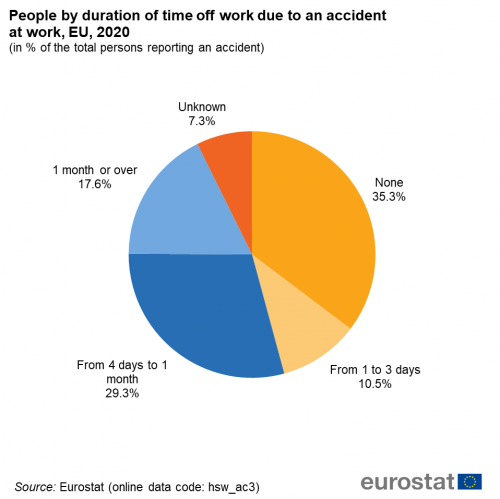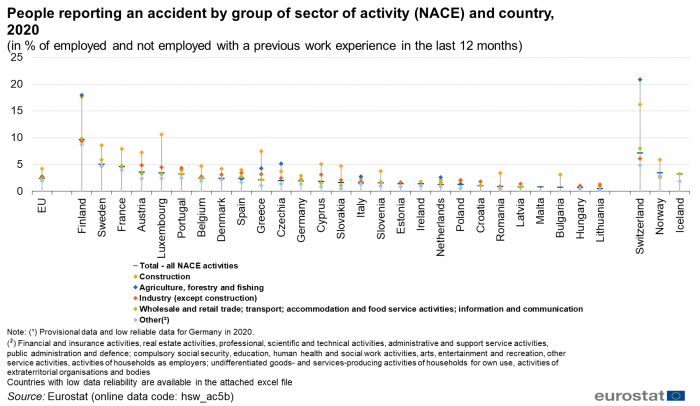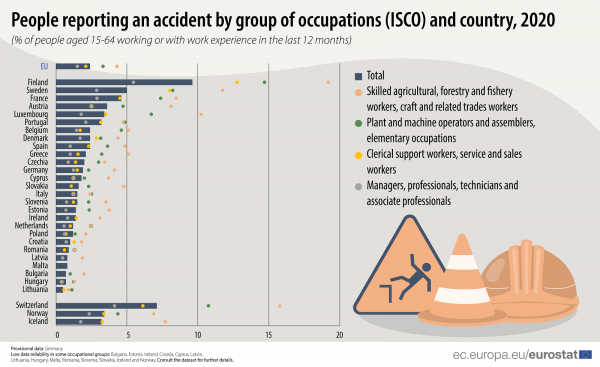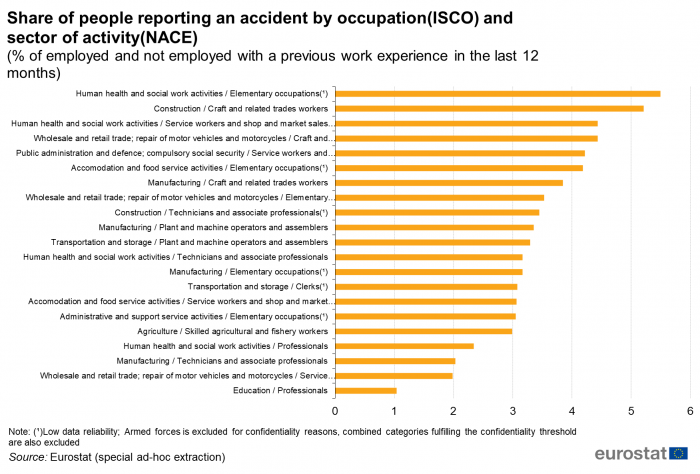Self-reported accidents at work - key statistics
Data extracted in September 2021
Planned article update: 2029 (with availability of LFS 2028 module)
Highlights
In 2020, 2.4 % of people working or with work experience in the last 12 months reported an accident at work in the previous year.
The highest incidence of work accidents in the EU was recorded in the construction sector in 2020: 4.2 % of people employed in that sector were concerned.
This article presents the main statistical indicators on non-fatal accidents at work in the European Union (EU) and the European Free Trade Association (EFTA) collected in the 2007, 2013 and 2020 ad hoc modules of the EU Labour Force Survey (EU-LFS), with, however, a focus on the 2020 data. The data presented in this article cover people aged 15 to 64.
The analysis mainly refers to persons who were either in work at the time of the interview or who had worked at any time during the previous year.
Data included in this article complements information from the administrative data collection on fatal and non-fatal accidents at work (see article on European Statistics on Accidents at Work (ESAW)) and other health and safety at work data from the same EU LFS ad hoc modules on self-reported work-related health problems and risk factors.
An accident at work is a single event occurring during working hours which leads to physical harm. Non-fatal accidents at work may involve considerable consequences for the concerned workers (such as disability or other health issues) but not necessarily. Accidents at work do not always result in absence from work. Fatal accidents at work are excluded from the data collected from the Labour Force Survey, as questions concerning accidents at work were directly posed to people who were in work or people who had worked during the year prior to the survey (hence, by definition they were alive).
Full article
Incidence of age and gender
In 2020, the share of people in the EU who reported at least one non-fatal accident at work (hereafter referred to simply as an accident) during the previous 12 months was 2.4 %, significantly lower than the 3.2 % share that was recorded in 2007 and the 2.8 % share recorded in 2013 (see Figure 1). This figure includes both people employed at the time of the interview and those not employed but who had worked during the year before the interview.
It is worth noting that 2020 has been characterised by the COVID-19 pandemic and its strong impact on businesses. All countries have not been affected in the same way by lockdowns and enterprise shutdowns, therefore each country should be considered as regards to its labour market and economic situation in 2020. For more information on the labour situation in 2020 in each EU Member State, please consult the annual articles on employment and labour market slack.
Younger people (aged 15 to 34) showed, in 2020, a higher incidence of accidents than older people (aged 35-64). At EU level, 2.7 % of people aged 15 to 34 reported an accident compared with 2.2 % among people aged 35 to 64. However, the share recorded for younger people decreased in 2020 compared to 2007 and 2013, when it reached 3.6 % and 3.1 % respectively.
Moreover, in 2020, 2.8 % of men who were employed or had work experience in the last 12 months reported an accident, while it amounted to 1.8 % for women. The difference between men and women is therefore 1.0 p.p. in 2020 while it stood at 1.3 p.p. in 2013 and 2.0 p.p. in 2007. The gender gap seems to narrow as time goes by. The development for men and women differs: accidents at work for men show a downward trend taking as reference the three years 2007, 2013 and 2020 (-0.7 p.p. in 2013 compared to 2007, and -0.6 p.p. in 2020 compared to 2013) while the number of accidents for women remained stable from 2007 to 2013 and decreased from 2013 to 2020 (-0.3 p.p.).

(in % of employed people or with previous work experience in the last 12 months)
Source: Eurostat (hsw_ac1)
Comparison with accidents resulting in time off work
As shown in Figure 2, the incidence of accidents in 2020 among the EU Member States ranged from less than 0.8 % in Bulgaria, Hungary and Lithuania, to 4.6 % in France, 5.0 % in Sweden and 9.6 % in Finland. Switzerland also stood out with 7.1 % of people employed or with a previous work experience in the last 12 months who reported an accident at work.
Nevertheless, this should be contrasted with the share of people reporting an accident that resulted in absence from work. Finland still ranked first but with a percentage much lower, i.e. 3.2 %. The reason is that, in Finland, only one third of people reporting an accident at work stated that the accident resulted in time off work. France ranked second with 2.8 % of people reporting an accident resulting in absence from work, followed by Austria (2.7 %), Luxembourg (2.3 %) and Portugal (2.2 %). On the opposite end of the scale, in Croatia, Romania, Bulgaria, Hungary, Lithuania and Latvia, 0.5 % or less of people employed or with previous work experience in the last year reported an accident that involved time off work.
In Malta, Lithuania, Italy, Poland and Czechia, more than 8 in 10 persons reporting an accident at work mentioned that it also resulted in time off work. In Switzerland, around half of those who had an accident at work also reported time off work. In Sweden, Finland, as well as in Norway, it only concerned around one third of people reporting an accident.
It should be noted that the significant differences between countries may originate not only in different working conditions and economic structures, but also in different treatment, compensation, reporting and prevention of accidents. The differences between countries mirror to some extent the differences in the administrative data collection European Statistics on Accidents at Work (ESAW) and in self-reported work-related health problems and risk factors of the same ad hoc module of the EU labour force survey (EU-LFS).
At EU level, as mentioned previously, 2.8 % of men who were employed or who had recent work experience reported an accident at work in 2020, while it affected 1.8 % of men if the focus is only on accidents at work resulting in time off work. Women also showed a difference in both shares: 1.8 % reported an accident but this share drops to 1.1 % if only women who had an accident at work resulting in absence from work taken into account.
Looking at Figure 3, the most noticeable differences between men and women in the EU who reported an accident at work, were found in Austria (2.9 p.p.), Finland (2.2 p.p.), Slovakia (1.9 p.p.), Cyprus and Czechia (both 1.7 p.p.) and Greece (1.6 p.p.). Switzerland reported the highest with 3.7 p.p. The same countries together with Estonia and Luxembourg showed differences greater than 1 p.p when considering the share of men and women who reported an accident at work resulting in absence from work.
With respect to potential absences from work due to an accident, slightly more than one third (35.3 %) of people who had an accident at work did not report any absence from work in the EU. Very short term absences after an accident were not so frequent as only 10.5 % of affected people reported a time off work from one to three days. The most frequent type of absences was from four days to one month which was reported by more than one fourth of working people (29.3 % exactly). Furthermore, 17.6 % stated that their time off work exceeded one month (see Figure 4).

(in % of the total persons reporting an accident)
Source: Eurostat (hsw_ac3)
Most affected sectors of activity and occupations
Construction standing out
Figure 5 shows the most affected sectors of activity as regards accidents at work for the population aged 15 to 64 in 2020. The sector of activity is based on the actual job of the person, i.e. the job where the accident had occurred - the main, the second or the previous job. In the EU, 2.4 % of people working or having previous work experience in the last year reported an accident in 2020 regardless of the sector of activity against 3 % or more in the four following sectors in 2020. The sector of construction ranked first with 4.2 % of people concerned. Followed by people employed or with previous experience in the sector of human health and social work activities as well as people in the accommodation and food service activities: in both sectors, 3.2 % reported an accident at work in 2020. Furthermore, 3.0 % of people in enterprises in the sector of transportation and storage reported an accident at work during the same period.
Education, "other service activities", professional activities and the group consisting of information and communication, real estate activities, financial and insurance activities, activities of households as employers, undifferentiated goods and services producing activities of household for own use and activities of extraterritorial organisations and bodies all showed a share below 1.5 % of people reporting an accident in 2020.
Figure 6 indicates, for each EU Member State and where data is available, the share of people aged 15 to 64 having had an accident and employed in different groups of sectors of activity. Among 22 EU Member States for which data for construction is available, this sector of activity ranked first in 15 countries in 2020 and shows the same share as industry in Hungary. In four countries, the sector of agriculture, forestry and fishing is the sector with the highest incidence of accidents at work.
Among the countries where construction is the sector with the highest proportion of workers having had an accident at work, Finland and Luxembourg, as well as Switzerland, reported the highest shares with more than 1 in 10 persons affected by an accident in 2020 (17.6 %, 10.6 % and 16.2 % respectively).

(in % of employed and not employed with a previous work experience in the last 12 months)
Source: Eurostat (hsw_ac5b)
Skilled agricultural, forestry and fishery workers, craft and related trades workers ranking first almost all EU Member States
With respect to occupational category, the share of people employed or with work experience in the last 12 months who reported an accident at work in the EU exceeded 3 % in the following occupations in 2020 (see Figure 7): craft and related trades workers (4.4 %), plant and machine operators and assemblers as well as skilled agricultural and fishery workers (both 3.4 %) and people with elementary occupations (3.3 %). By contrast, 1.2 % or less people reported an accident at work among clerks (1.2 %), legislators senior officials and managers and professionals (both 1.1 %).
At national level, for reliability reasons, data is presented according to broader groups of occupations. Figure 8 clearly shows that the vast majority of countries present the same pattern. Among 18 EU Member States for which data is available for all groups, the share of people reporting an accident for the group of skilled agricultural, forestry and fishery workers, craft and related trades workers is the highest in the majority of countries (15 out of 18). The category of plant and machine operators and assemblers and elementary occupations ranked second in most countries followed by the group of clerical support workers and service and sales workers and the managers, professionals and technicians and associate professionals.

(in % of employed and not employed with a previous work experience in the last 12 months)
Source: Eurostat (hsw_ac7)
Highest share of accident for people with elementary occupations in the health sector
Crossing the sector of activity of people and the occupation in their actual job at EU level as done in Figure 9, the highest share of people reporting an accident is found among people having elementary occupations in the health sector: 5.5 % reported an accident at work in 2020. Closely followed by craft and related trade workers in the construction sector with 5.2 % of people declaring an accident at work in 2020. Furthermore, 4.4 % of people employed as service workers and shop and market sales workers, those in the sector of human health and social work activities as well as craft and related trade workers in the sector of wholesale and retail trade; repair of motor vehicles and motorcycles also reported an accident in 2020, being the third and fourth categories with the highest incidence. Service workers were also above 4 %, and shop and market sales workers working in activities related to the public administration and defence or compulsory social security as well as people having elementary occupations in accommodation and food service activities both registering a share of 4.2 %.
With the lowest share were technicians and associate professionals employed in manufacturing activities, service workers and shop and market sales workers in enterprises related to wholesale and retail trade; repair of motor vehicles and motorcycles and finally, professionals in the education sector all recorded the lowest shares with 2.0 % or less of employed people reporting an accident.
The ranking visible in Figure 8 does not include the combinations of occupation and sector of activity for which the number of people reporting an accident is too low to be displayed due to reliability and confidentiality thresholds. Given these reliability and confidentiality rules applied to the number of people reporting an accident, it can be easily deduced that other combinations of occupational category and sector of activity would very likely record lower shares but their low number does not allow for the figures to be shown.
Role played by atypical working time
Figure 10 presents the share of people reporting an accident by type of working time. In two thirds of EU Member States (14 out of 20 for which all data is available), people who usually worked atypical working times recorded higher shares of accident at work in 2020 compared to those working sometimes or never atypical working times. Atypical working time refers to work which is not performed during social hours (e.g. during the night, on weekends, etc.).
At EU level, 3.1 % of people working under atypical working time pattern reported an accident in 2020. Those working only sometimes outside social hours reported a share of 2.1 % and of 2.0 % when considering only people never working atypical working hours. In Finland, Luxembourg and Portugal as well as in Switzerland, the gap between the share of people reporting an accident working usually under atypical working times and those working only sometimes under atypical working times amounted to 2 p.p. or more.

(in % of employed people)
Source: Eurostat (hsw_ac11)
Source data for tables and graphs
Data sources
The European Union Labour Force Survey (EU-LFS) is carried out as a sample survey of people living in private households every quarter. In addition, since 1999, an ad hoc module is added to the survey each year focusing on a particular issue: in 2007, 2013 and 2020, the ad hoc module included questions concerning self-reported accidents at work, work-related health problems, and factors that can adversely affect mental well-being or physical health. Regulation (EU) 2019/1700 states that a module on accidents at work and work-related health problems is conducted every 8 years from the reference year 2020 onwards.
For further information on the EU-LFS modules, please refer to the article on this subject.
Coverage: The EU-LFS 2020 module on accidents at work and work-related health problems was conducted in all EU Member States as well as the EFTA Member States of Iceland, Norway, Switzerland. For Cyprus, the survey covers only the areas of Cyprus controlled by the Government of the Republic of Cyprus.
Country note: In Germany, since the first quarter of 2020, the Labour Force Survey (LFS) has been integrated into the newly designed German microcensus as a subsample. Unfortunately, for the LFS, technical issues and the COVID-19 crisis has had a large impact on the data collection processes, resulting in low response rates and a biased sample. The published German data are preliminary and may be revised in the future.
European aggregates: EU refers to the sum of EU-27 Member States. If data are unavailable for a country, the calculation of the corresponding aggregates takes into account the data for the same country for the most recent period available. Such cases are indicated.
Reference population: While the EU-LFS covers all persons aged 15 and over, the data presented in this article concern people aged 15 to 64. The questions concerning accidents at work were asked to people who were either in work at the time of the interview or who had worked at any time during the previous year.
Classifications: In this article, data presented by activity are based on NACE Rev. 2. Data by occupation are presented according to the international standard classification of occupations which is maintained by the International Labour Organisation (ILO). Data for 2020 are based on ISCO-08.
Definitions:
The data presented includes accidents that occurred i) at work (including during breaks) or ii) in the course of the respondents' work (if not on the premises; therefore excluding off-site breaks and travelling). All other types of accidents are excluded, for example travelling between home and the workplace (or travelling for breaks); home and leisure accidents; transport accidents in the course of private activities. Occupational diseases or illnesses are also excluded. Only accidents that resulted in injury are included, regardless of whether they needed treatment or not and regardless of whether or not they resulted in sick leave. Fatal accidents (which are rare) are not covered by the survey.
The analysis of the length of absence due to an accident is based strictly on days of absence related to the accident/problem, not subsequent consequences (such as unemployment).
For further information on the module's definitions and methodology, please visit: Explanatory notes for the LFS ad hoc module 2020 on "Accidents at work and other work-related health problems".
Atypical working time includes the evening / night work, Saturday / Sunday working and shift work.
For more information on the LFS variables and concepts, please consult: Explanatory notes for the core LFS.
Comparison with the administrative data collection:
On an annual basis, Eurostat also collects administrative data on accidents at work (referred to as European Statistics on Accidents at Work (ESAW)); see the accidents at work statistics article for more information. Compared with this annual collection, the labour force survey data used in this article give the following additional information:
- accidents with less than four days of absence from work;
- more detail concerning the occurrence of road traffic accidents;
- analysis by a range of additional socioeconomic characteristics (such as educational level, occupation and professional status);
- an improved comparability in relation to some issues of under-reporting between EU Member States or different types of sources (insurance, non-insurance based systems) used in ESAW, however these accidents at work remain self-reported.
By contrast, the administrative data (ESAW) provide information on fatal accidents as well as nine variables on causes and circumstances of accidents, such as the material agent (for example buildings, structures, machinery, tools, objects, chemicals and animals) involved in the accident, which are not covered by the labour force survey.
Context
A safe, healthy working environment is a crucial factor in an individual’s quality of life and is also of collective concern. Governments across the EU Member States recognise the social and economic benefits of better health and safety at work. Reliable, comparable, up-to-date statistical information is vital for setting policy objectives and adopting suitable policy measures and preventive actions. For more information please refer to this article based on administrative data (ESAW).
In December 2008, the European Parliament and the Council adopted Regulation (EC) No 1338/2008 on Community statistics on public health and health and safety at work. The Regulation is designed to ensure that health statistics provide adequate information for all EU Member States to monitor Community actions in the field of public health and health and safety at work.
In April 2011, a European Commission Regulation (EU) No 349/2011 on statistics on accidents at work was adopted specifying in detail the variables, breakdowns and metadata that EU Member States are required to deliver; this legislation was implemented in a number of phases.
The EU-LFS 2020 module on "Accidents at work and health-related work problems" can be used as a complementary data source to ESAW and support in providing a broader view on Health and Safety at Work from a different perspective.
Direct access to
- Health (hlth), see Health and safety at work (hsw):
- Accidents at work and other work-related health problems (source LFS) (hsw_apex)
- Accidents at work (hsw_ac)
ESMS metadata files
- Accidents at work (ESAW, 2008 onwards) (ESMS metadata file — hsw_acc_work_esms)
- Accidents at work and other work-related health problems (source LFS) (ESMS metadata file — hsw_apex_esms)
- Employment and unemployment (Labour Force Survey) (ESMS metadata file — employ_esms)
- LFS ad-hoc modules (ESMS metadata file — lfso_esms)
Publications
- European statistics on accidents at work (ESAW) — Summary methodology — 2013 edition
- EU labour force survey — online publication
- Labour force survey in the EU, EFTA, United Kingdom and candidate countries — Main characteristics of national surveys, 2019, 2021 edition
- Quality report of the European Union Labour Force Survey 2019, 2021 edition





